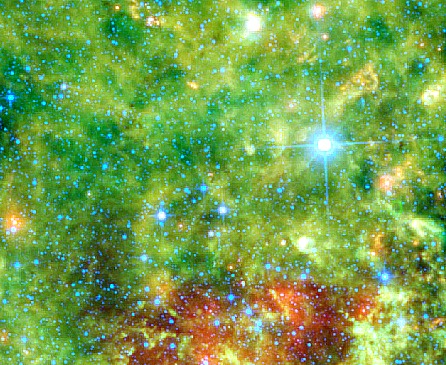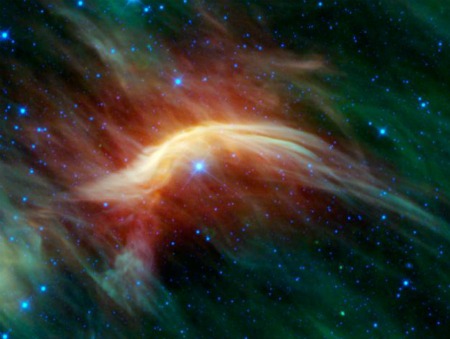The NASA WISE telescope spent a year imaging sections of the sky in infrared and astronomers have been working for the last few months to knit it together in a 360 degree map, all doped up with false color. It is spectacular. The limitations of this website can’t do it justice: that bad boy above is scalable like you wouldn’t believe. (Speaking of which, don’t click on the last image or two if your PC bitches about large pics, one of them is width 54000, which auto scales to 5400 on some devices and still causes fits). Let’s take a little piece of it on the far left and zoom in, so you can see what this means.
Whoa! And bear in mind, what you’re seeing isn’t even visible in optical light telescopes. That stuff up there is partly or completely obscured by dust and gas. That’s why infrared is the Big Thing in observational astronomy these days, it lets us peek through the cosmic fog and see things we’ve never seen before, even with the most powerful traditional scopes. But, maybe we want more detail, let’s grab that blob in the upper left corner and zoom in some more.
Still not impressed? How about this.
It goes on like that for several more magnitudes, or so I’m told anyway. That detail isn’t posted yet (This was only released on 14 March). Throughout the data are details on the gas and dust itself that tell astronomers a story of raw power and violence, a universe in frenzied motion, as active as swarms of a billion angry bees.
The image below, taken from the breathtaking slide show here, hints at some of that: a massive star that was probably hurled through the cosmos when its close companion disintegrated in a super nova. Like cutting a string on a twirling ball, it is now moving so fast its piling up a hot shockwave and streaming molecular debris. Think of a star-sized bullet ripping through super heated gas caught by an ultra fast motion camera. (Astronomers speculate similar dynamics playing out near the heart of large galaxies could generate entire star systems, with planets in tow, zipping out of their starry host at hundreds of kilometers a second, trailng streamers hundreds of light-years long in their wake) Only the vast distances involved in this case freeze the action and capture a transient moment of astounding beauty.
The amazing part, this isn’t one series of shots, WISE operated for a little over one year, from Dec 2009 to Feb 2011, using only a 40 cm IR detector looking in a few bands of invisible and reddish light. But it mapped the entire sky like this and archived it for future research. We’re talking about a single image, that if laid out in high res would cover a small town. There is detail and data and new info in there that will be examined and appearing for the first time in thesis and dissertation for decades to come.
WISE was tasked to create the first infrared cosmic atlas, a mere over view informing future astronomers where to look. This week we get a small taste of what it really did with lots more to come — there may not be enough people in the field to analyze an appreciable fraction of it in really close detail, even if they worked non-stop for a century. In the future, if and when astronomers and students strap on virtual reality goggles and ply the stellar winds of the real universe in gritty three-D, they could be riding through a virtual environment created by WISE at thousands of times the speed of light!
That brings up a fair point for discussion: NASA currently has a much larger verison of WISE in the works called the James Webb Space Telescope. Instead of a 40 cm collector in low earth orbit, JWST sports a 6.5 meter maw in lolling on the edge of interplanetary space. After seeing what WISE produced, you can imagine — or maybe we can’t and that’s what so exciting — what a dish with over 250 times the collecting power of WISE could do! The worry is JWST may be trying to do too much too soon, without an intermediate step, plus it’s so expensive and subject to so many delays already, its gutting NASA’s interplanetary science budget right now.
If we going to have to cancel missions to Mars (Or Europa, or terrestrial planet finders, or a freakin Jovian stratospheric floater, etc) that we’ve already sunk big space bucks into, might it make more sense to consider a smaller version of JWST, say a two meter dish that would have 25 times the power and be operational years sooner? That’s still a huge leap in resolution. Then again just having that constraint forced on us by so-called fiscal conservatives is laughable given their track record: the entire cost of the WISE mission was roughly 350 million dollars. That’s about what it cost to prop up Wall Street for a few hours after Republican economic policies crashed the economy, or chase after non existent WMD for a couple of days in Iraq at the bloody nadir of that one incredible blunder.






Excellent. I remember wtaching the launch of WISE does seem like that long ago. Now the mission is over – but the data is still pouring in and being poured over. Cheers! :-)
opps – that’s : doesn’t seem like that long ago.
Wonderful, thanks for posting this. I keep on saying, when you see things like this, adding a god into the picture makes it smaller.
Forty centimeters in LEO and we got that! Think what a 2 meter dish would do … makes mwe wonder why James Webb has to have a 6.5 meter collector and hang out in interplanetary space cooled to zero? Granted it would be amazing if it worked, but it seems like over kill, it’s definately killing planetary science. I understand better now what one NASA source told me on background: it’s trying to do too much at once without an intermediate step, and that intermediate step would return fantastic data sooner and for like a tenth the cost.
Thanks for bringing this to my attention! Wonderful.